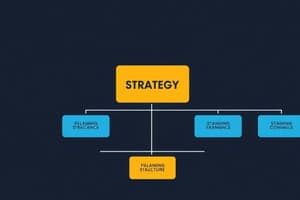Podcast
Questions and Answers
What type of organizational structure is most suited for a stable environment?
What type of organizational structure is most suited for a stable environment?
- Virtual Structure
- Organic Structure
- Functional Structure
- Mechanistic Structure (correct)
Which structural type allows for flexibility and faster decision-making?
Which structural type allows for flexibility and faster decision-making?
- Organic Structure (correct)
- Matrix Structure
- Functional Structure
- Divisional Structure
In which era did the transition from a primarily mechanistic structure to a more diverse organizational design begin?
In which era did the transition from a primarily mechanistic structure to a more diverse organizational design begin?
- Third Era
- Post-Agricultural Era
- Second Era (correct)
- Early Era
Which organizational structure involves teams formed from various departments?
Which organizational structure involves teams formed from various departments?
What characterizes a virtual structure within an organization?
What characterizes a virtual structure within an organization?
What defines authoritarian/autocratic leadership?
What defines authoritarian/autocratic leadership?
Which trait is essential for effective leadership and involves understanding and managing one's own emotions and those of others?
Which trait is essential for effective leadership and involves understanding and managing one's own emotions and those of others?
How does transformational leadership primarily differ from laissez-faire leadership?
How does transformational leadership primarily differ from laissez-faire leadership?
What aspect of motivating employees focuses on the drive or inspiration that leads to action?
What aspect of motivating employees focuses on the drive or inspiration that leads to action?
What type of leadership values each individual's opinion and collaborates with the team to make decisions?
What type of leadership values each individual's opinion and collaborates with the team to make decisions?
Flashcards
Mechanistic Structure
Mechanistic Structure
A hierarchical organizational structure, suitable for stable environments and predictable industries.
Organic Structure
Organic Structure
A flexible organizational structure designed to respond quickly to changes in a dynamic environment.
Functional Structure
Functional Structure
Organization categorized by specialized departments like marketing and finance.
Divisional Structure
Divisional Structure
Signup and view all the flashcards
Networked/Team-Based Structure
Networked/Team-Based Structure
Signup and view all the flashcards
Leadership
Leadership
Signup and view all the flashcards
Authoritarian Leadership
Authoritarian Leadership
Signup and view all the flashcards
Laissez-faire Leadership
Laissez-faire Leadership
Signup and view all the flashcards
Democratic Leadership
Democratic Leadership
Signup and view all the flashcards
Transformational Leadership
Transformational Leadership
Signup and view all the flashcards
Study Notes
Organizational Structure and Design
- Organizational structure and design are crucial components in strategic management
- Mechanistic structures are suitable for stable industries, emphasizing hierarchies and predictable decision-making
- Organic structures promote flexibility and faster decision-making, suitable for dynamic environments
Early Theories of Organizational Design
- Early organizational design theories focused on mechanistic structures, which are appropriate for stable environments
- Organic structures, on the other hand, are better suited for dynamic environments, enabling greater flexibility and adaptability
Evolution of Organizational Structure
- Early Organizational Structure Era (mid-1800s-1970s): Primarily focused on a mechanistic, top-down approach
- Second Organizational Structure Era (1980s-1990s): Rising global competition led to the need for more flexibility and adaptability.
- Third Organizational Structure Era (mid-1990s-Present): Adoption of modern structures like networked and virtual structures.
Types of Organizational Structures
- Functional Structure: Departments organized based on specializations (e.g., marketing, finance)
- Divisional Structure: Categorization by product, service, or region
- Geographic Structure: Structuring by region or location
- Matrix Structure: Employees report to two managers (functional and project)
- Networked/Team-Based Structure: Teams formed from various departments
- Virtual Structure: No physical office; relying on technology to connect teams
Studying That Suits You
Use AI to generate personalized quizzes and flashcards to suit your learning preferences.




